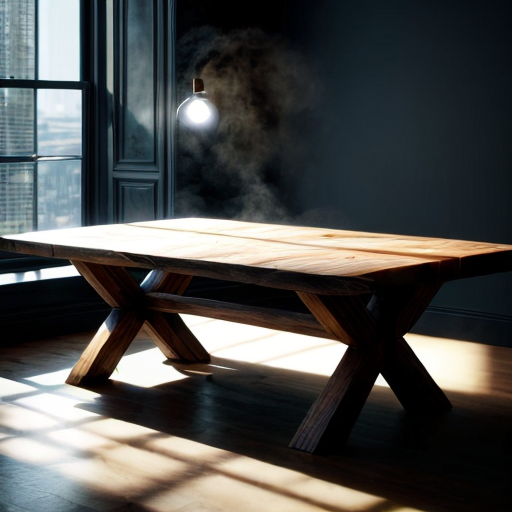So, you've decided to take on the noble task of building your own table. Bravo! Now, before you dive headfirst into the world of sawdust and splinters, let's talk about the most crucial element of your masterpiece – the wood. Selecting the perfect wood for your tabletop is like choosing the right partner for a dance-off. You want someone sturdy, reliable, and with a touch of elegance. Similarly, your table deserves a material that can withstand the chaos of family dinners, the occasional wine spill, and maybe even a wild game night. So, my dear DIY enthusiasts, let's embark on this wood selection journey together, and find the ideal match for your table – a wood that will make your guests go, 'Wow, this table is so amazing, I can't even handle it!'
An interesting fact about making a wood table top is that the process of creating a seamless and smooth surface involves a technique called 'woodworking magic.' This technique, known as 'butterfly joints' or 'dovetail keys,' involves the insertion of small, geometrically shaped pieces of contrasting wood into the natural cracks or splits in the table top. These pieces are carefully cut and fitted together, resembling the shape of a butterfly or a dovetail, hence the name. Not only do these decorative joints add visual appeal to the table top, but they also serve a functional purpose by preventing the cracks from expanding further and stabilizing the wood. This unique and artistic method not only showcases the craftsmanship of the woodworker but also adds a touch of elegance and character to the final piece.
Alright, fellow woodworkers, let's roll up our sleeves and get down to business – preparing the wood for our glorious table top. This step is like giving your wood a spa day, pampering it to perfection. First things first, we need to ensure our wood is clean and free from any unwanted blemishes. Sanding is our secret weapon here, smoothing out rough edges and imperfections like a magician erasing a bad haircut. Next, we must show our wood some love by applying a protective finish. Think of it as giving your table a stylish suit of armor, shielding it from the perils of spilled drinks and hot plates. So, my friends, let's prepare our wood with care and attention, because a smooth and durable tabletop is the foundation of a truly remarkable table.

Ah, the art of joining techniques – the secret sauce that holds our table together, creating a strong and seamless tabletop that will withstand the test of time. Picture this: you're hosting a dinner party, and your guests are marveling at the beauty of your handmade table. Little do they know, it's the invisible joints that are the unsung heroes of your masterpiece. So, let's dive into the world of joinery and unlock the secrets to creating a table that would make even the most seasoned carpenter shed a tear of admiration. First up, we have the classic butt joint – simple yet effective, like a good old-fashioned handshake. It involves joining two pieces of wood at a right angle, creating a clean and straightforward connection. But if you're looking for something a bit more sophisticated, the mortise and tenon joint is your go-to move. It's like a dance between two partners, with one piece of wood (the tenon) fitting snugly into a hole (the mortise) in the other piece. This joint not only provides strength but also adds a touch of elegance to your table. And let's not forget about the tongue and groove joint, a match made in woodworking heaven. It's like two puzzle pieces fitting perfectly together, creating a seamless connection that will make your table stand out from the crowd. So, my fellow woodworkers, let's master the art of joining techniques and create tabletops that are not only visually stunning but also built to last. Your guests will be in awe, and you'll have the satisfaction of knowing that your table is a true work of art, held together by the magic of joinery.
Fun fact: Did you know that to make a wood table top, the wood boards are often joined together using a technique called 'biscuit joining'? This involves cutting small, oval-shaped slots (known as biscuits) into the edges of the boards, which are then glued together. These biscuits help align and strengthen the joint, creating a seamless and sturdy table top. So, next time you admire a beautiful wood table, remember that it might be held together by tiny biscuits!
Now, let's talk about the finishing touches – the cherry on top of your wood table masterpiece. Applying the perfect finish is like adding a touch of magic that enhances the beauty and longevity of your tabletop. Think of it as giving your table a makeover, transforming it from a plain piece of wood into a stunning focal point of your space. Whether you prefer a natural, rustic look or a sleek, polished finish, there are plenty of options to choose from. From oils and waxes to varnishes and lacquers, each finish has its own unique qualities and benefits. Not only does a good finish protect your table from daily wear and tear, but it also brings out the natural grain and color of the wood, adding depth and character. So, my fellow woodworkers, take your time to select the perfect finish for your table, and watch as it elevates your creation to a whole new level of beauty and durability. Your table will be the envy of all who lay eyes upon it, and you'll have the satisfaction of knowing that you've created a piece that will last for generations to come.